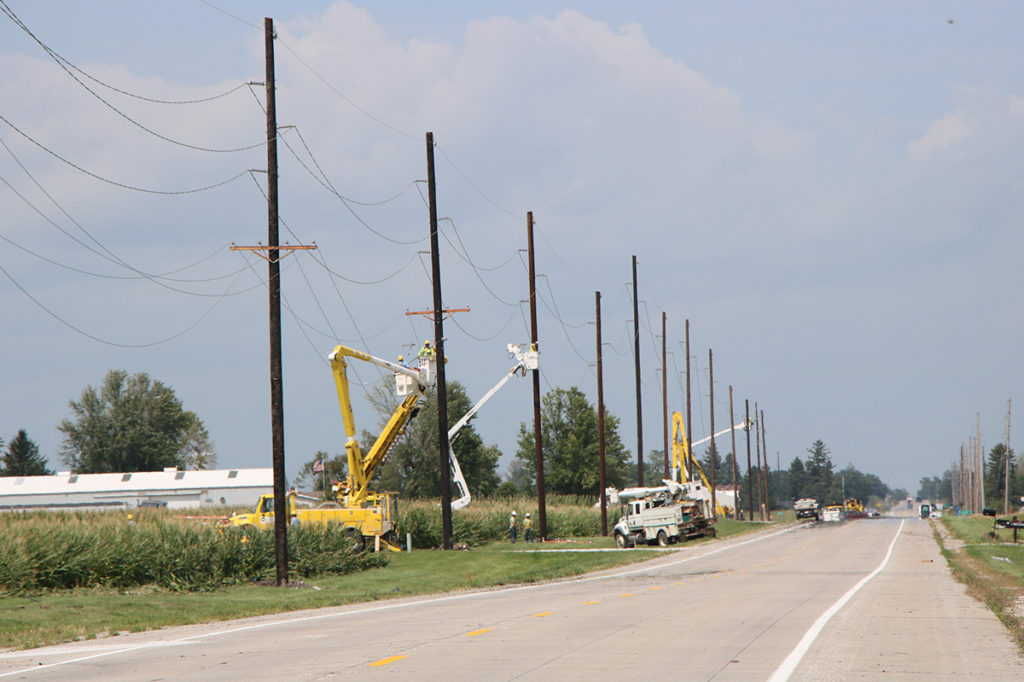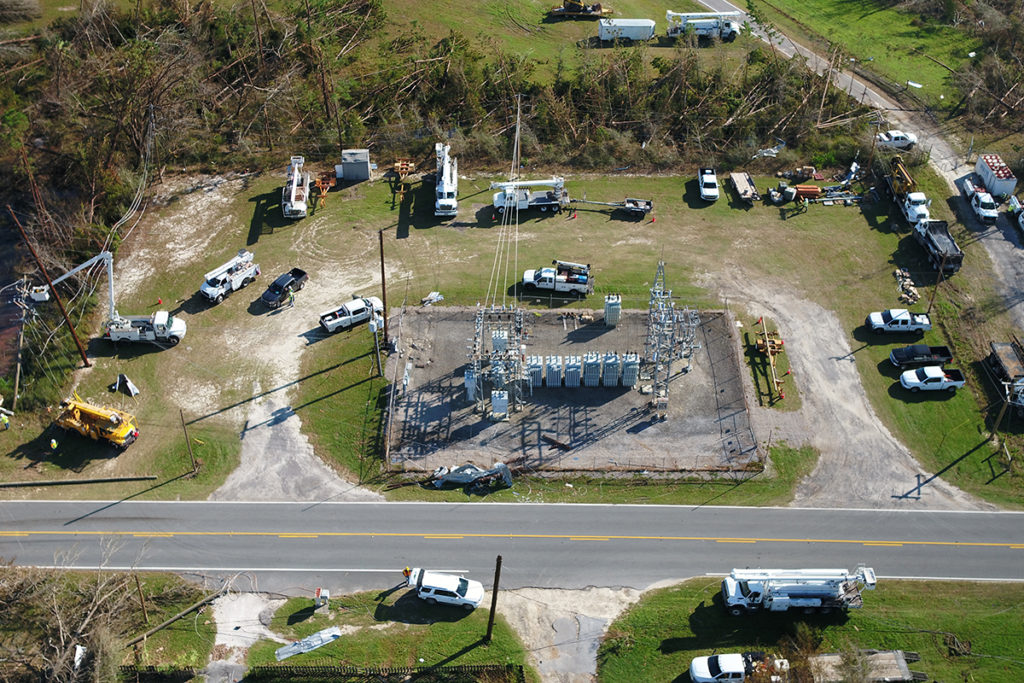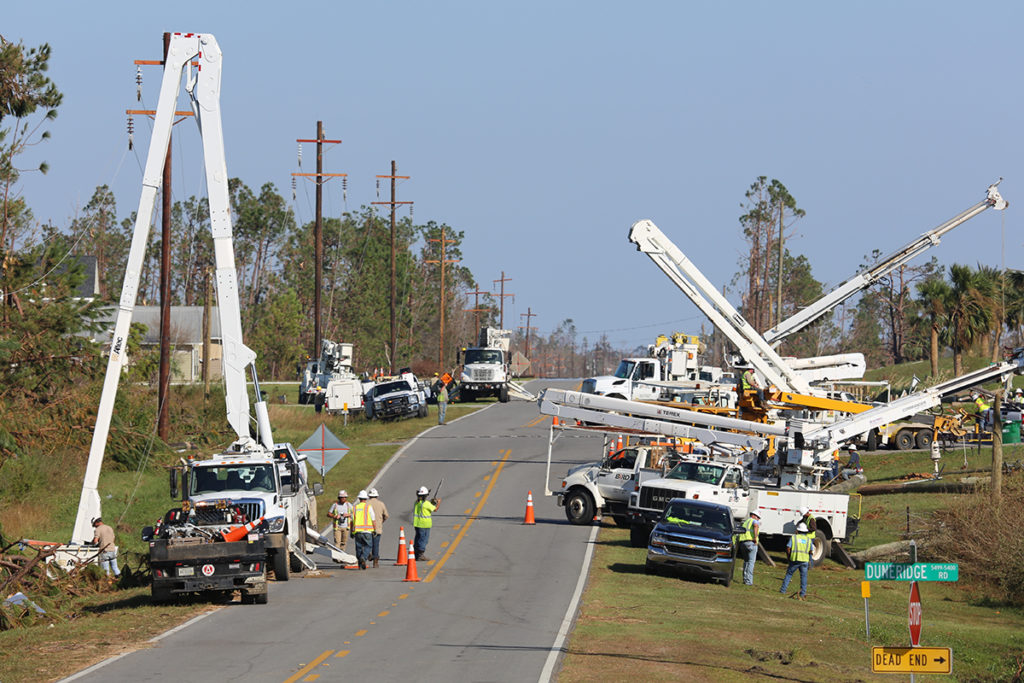
Massive storms can ravage the electric grid, leaving tens of thousands of utility meters stalled until distribution systems are repaired. But the damage caused to transmission systems can present far different challenges for the people who restore power.
That’s why more than two weeks after Hurricane Laura made landfall on the Louisiana coast, two electric cooperatives are still telling members they may not have power fully restored for weeks.
The investor-owned utilities that control transmission assets in western Louisiana began damage assessments and the process of rebuilding their systems within hours after Laura came ashore on Aug. 27 near Cameron.
While the Louisiana distribution co-ops are not involved in rebuilding the regional transmission system, two generation and transmission cooperatives have had recent experiences with widespread damage, prompting emergency system reconstruction well beyond the scope of routine storm repairs.
When a derecho swept across the Midwest on Aug. 10, Central Iowa Power Cooperative reported outages affecting 58,000 homes and businesses. The storm’s 130-mph winds cut a path of destruction across the state estimated at 70 miles wide and 200 miles long.
“We found miles of line strewn over highways and pole after pole blocking roads,” said Dan Burns, vice president of utility operations for the Cedar Rapids-based G&T. “You couldn’t get trucks in to begin rebuilding the lines, so the first thing we had to do was clear all of that out.”
About 600 of CIPCO’s transmission structures were knocked down, said Burns. “We had damaged infrastructure in 11 counties, and more than 100 of our member co-ops’ distribution substations were offline.”
The damage was comparable to losses experienced by Andalusia, Alabama-based PowerSouth Energy Cooperative during Hurricane Michael. The G&T lost 264 transmission structures after Michael made landfall as a Category 5 storm on the Florida Panhandle in 2018.

“Michael came through the Panama City area, and the devastation was complete,” said Gary Smith, PowerSouth’s president and CEO. “The path of destruction was about 60 miles wide, centered right at Tyndall Air Force Base, and extended about 120 miles deep.”
Specialized Help
The electric power grid is a sophisticated system of complex parts, deployed and installed over many decades.
The basic parts include generation assets like power plants, solar arrays and wind farms; transmission systems that carry high-voltage electricity along conductors supported by tall poles, steel towers or wood-framed structures; and distribution systems that include substations that reduce and divide high-voltage electricity into lower-voltage amounts to safely distribute power to homes, farms and businesses.
Each element of the grid requires personnel with specific skills. Those involved in building, repairing and maintaining them have their own work procedures, as well as specialized tools, vehicles and equipment.
That can become particularly challenging when major disruptions prompt emergency rebuilds. The pool of available workers who can safely and quickly respond to a transmission provider’s needs is relatively small compared to those trained to help a distribution operator.
“Our guys work on high-voltage lines, and they do it a certain way,” said Smith. “There are not a lot of co-ops in our region of the country that build and maintain their own transmission, so we got help from Cooperative Energy, a G&T out of Hattiesburg, Mississippi, and we used contractors.”
PowerSouth divided personnel so that a representative of the G&T, familiar with its systems and procedures, was paired with each contract or mutual aid crew.
With 20% of PowerSouth’s transmission system down, it quickly became clear that damaged segments could be rebuilt faster than they could be repaired.
“With a normal storm, like a tornado, you can straighten structures, replace cross arms and straighten and rehang conductor and keep moving,” said Smith. “This was all destroyed, so we just rolled it up and put everything back new. That made it a total rebuild.”
CIPCO was in a position to harness more mutual aid when the derecho tore through Iowa, so when preliminary damage assessments turned up widespread problems, CEO William Cherrier contacted his counterparts at four other G&Ts to begin coordinating a collective response.
Iowa’s Corn Belt Power Cooperative and Northwest Iowa Power Cooperative, Northeast Missouri Electric Power Cooperative and Wisconsin’s Dairyland Power Cooperative were happy to help.
“We had not called for mutual aid help before, and we were wondering exactly how that worked as far as having agreements and such, but that turned out to be the easiest part of the entire event,” Burns said. “We just called them and said we need help, and they came, with crews, trucks and any materials they had on hand. By the time they got here, we knew where we needed them most. But the hours required for an emergency rebuild when everybody’s power is out can be tough on crews. They worked 16 to 17 hours a day for 12 days in a row, which is far more intense than a normal rebuild.”
Managing Movements and Many Parts
Big projects always require a lot of planning, and when that’s undertaken in response to major system failures, engineers and logistics planners look for ways to quickly meet the challenges.
“The first three days are complete chaos, and then things start coming together,” recalled Smith, describing the rebuild required after Hurricane Michael. “There are photos and mapping data gathered from helicopter and drone flyovers to analyze, parts inventories to compile and review, basecamp locations to plot, and lodging and meal services to arrange.”
“You are always prepared for the smaller repair jobs, but you are never fully prepared when systems have to be totally rebuilt,” said Smith.
To expedite restoration, work plans are plotted to allow reconnection to less damaged sections of the grid that often restore service to the most densely populated areas.

“When your crews and contractors get stretched out, they’re moving quickly and putting up a number of structures simultaneously,” said Smith. “You’ll have two or three crews on the same line working on structures. When they get finished, they’ll leapfrog, often moving right behind the crews laying out the matting and cribbing needed to support heavy equipment in wet cross-country areas.”
Keeping those crews moving requires a supply chain designed to work with military precision. That means starting with what’s on hand and then identifying sources that can guarantee fast resupply and delivery to temporary yards often set up at 50-mile intervals.
“We had some planned rebuild projects that were just about to begin construction, and so we robbed a lot of that material,” said Burns, recalling the first few days following Iowa’s derecho.
CIPCO’s vendor management team contacted suppliers, who shipped more poles, insulators and other components. But, at times, there never seemed to be enough.
“We ran short on most materials, because our needs were 10 times greater than the inventory we had,” said Burns. “On a normal planned rebuild, you know from the plan and profile designs the exact quantities needed of each pole class and length. In an emergency response situation, you need to expedite delivery of poles, and you can’t always be specific. You often shoot from the hip just to keep the rebuild going.”
CIPCO restored transmission service to all distribution substations within 12 days of the derecho, but crews will be involved in follow-up work for months.
Emergency rebuilds present ongoing maintenance challenges that can impact operations for years. New parts and poles are comingled with assets deployed decades ago, and all the changes and updates must be noted and confirmed in the transmission asset database. More visual inspections than would take place under a scheduled rebuild may also be needed.
“We decided to defer some things in order to get power back on as quickly as possible,” said Burns. “For example, we put up the poles, insulators and conductor, but we decided to defer the pole grounds until a later date. That sped up restoration time considerably. Now that the system is back to normal, we can go back and install them without interrupting service to members.”
Just as every storm presents unique challenges, emergency rebuilds are seldom routine.
“You cannot comprehend the devastation and the chaos,” said Smith. “I’ve been CEO 21 years and, for me, Michael was the worst storm we have seen, and you’re never prepared for your worst storm.”
Derrill Holly is a staff writer at NRECA.